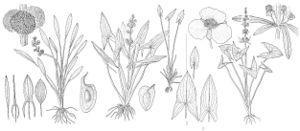Alismataceae
Herbs, annual or perennial, rhizomatous, stoloniferous, or cormose, caulescent, glabrous to stellate-pubescent; sap milky. Roots septate or not septate. Leaves basal, submersed, floating, or emersed, sessile or petiolate, sheathing proximally; blade with translucent markings of dots or lines present or absent, basal lobes present or absent; venation reticulate, primary-veins parallel from base of blade to apex, secondary-veins reticulate. Inflorescences scapose racemes or panicles, rarely umbels, erect, rarely floating or decumbent, whorled (forming racemes) or whorls branching (forming panicles), bracteolate. Flowers bisexual or unisexual, if unisexual, staminate and pistillate on same or different plants, hypogynous, subsessile to long-pedicellate; sepals persistent, 3; petals deciduous, 3, delicate; stamens 0, 6, 9, or to 30, distinct; anthers 2-loculed, dehiscing longitudinally; pistils 0 or 6–1500 or more, distinct or coherent proximally, 1-loculed; placentation basal; ovules1–2. Fruits achenes or follicles. Seeds: embryo U-shaped; endosperm absent in mature seed.
Distribution
Nearly worldwide, primarily tropical and subtropical regions
Discussion
Genera 12, species ca. 80 (4 genera, 34 species in the flora).
Selected References
Lower Taxa
Illustrations
Key
| 1 | Pistils weakly coherent proximally into starlike aggregation; petals erose | Damasonium |
| 1 | Pistils distinct, forming heads or rings; petals entire. | > 2 |
| 2 | Pistils arranged in ring around margin of flattened receptacle. | Alisma |
| 2 | Pistils spirally arranged on convex receptacle. | > 3 |
| 3 | Flowers all bisexual; fruits mostly plump, longitudinally ribbed, lateral wings absent. | Echinodorus |
| 3 | Flowers unisexual (at least the proximal); fruits compressed, lateral wing often present, 1, curved. | Sagittaria |



